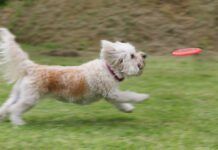It is heartbreaking to see your dog be scared and upset. To help your dog, stay calm yourself and try to make the situation less stressful for her if possible. Here are some strategies to use in the moment to comfort your dog.
Scared Dog? Stay Calm
You are your dog’s person, his caretaker and partner in life. When he is scared, he will naturally look to you for comfort. Your job in these situations is to stay calm and be his rock.
Talk to your dog in a slow, soothing tone. High-pitched baby talk can be tempting, but this may just exacerbate a fearful dog’s distress. Channel your inner Morgan Freeman to calm your dog. It doesn’t matter what exactly you say, but some easy options are to talk your dog through what is going on and what you are going to do next or use human panic attack strategies such as listing things in the environment that you and your dog can see, smell, hear, touch, and taste. Grounding yourself will help to ground your dog.
Keep your movements slow and fluid, avoiding jerking motions. Taking a few deep breaths can help you to physically relax, which in turn signals to your dog that he can relax.
Doing a “slow blink” when your dog is looking at you is a calming signal. This says to your dog, “See—I’m comfortable closing my eyes. There is nothing to worry about.”
Safety First
Quickly assess your dog’s safety—is she in a secure location? Does she have a well-fitted collar or harness and leash? Frightened dogs often bolt and are not thinking straight when motivated by fear. You want to prevent your dog from running into the road or disappearing into woods or your neighborhood.
While not a long-term solution, a slip lead is the most secure for these situations. If there is any chance that your dog can get out of her regular collar, you can create a makeshift slip lead by pulling the snap end of the leash through the handle to create a loop. Then place the loop over your dog’s head so that it will slide and become snug if your dog pulls or bolts.
The other plus to a slip lead is that you can make the loop large to carefully put it on a nervous dog without touching her. This is perfect for fearful dogs who may snap or bite if you try to grab their collar.
Offer Physical Comfort
Physical contact is beneficial for many scared dogs. Pet your scared shaking dog with long, slow strokes from head to tail. You can also gently massage her ears to promote relaxation.
If your dog enjoys cuddling, hold her close to your body so she can feel your heartbeat. Take slow, deep breaths to encourage your dog to relax and match your breathing patterns. These slow breaths will also help to slow your heartbeat. If your dog is not keen on being held, holding her may not be helpful.
If you do not know the dog that you are trying to comfort, proceed with caution. A scared dog may snap or bite if she feels cornered. If the dog becomes more agitated as you approach or reach for her, step back a little and break eye contact until she relaxes.
Distractions
You can use a variety of distractions to calm a scared, shaking dog. Treats are an excellent option if you have food available—many dogs love food and the act of eating provides comfort. You can use whatever food you have on hand as long as it is not toxic to dogs (save the chocolate to comfort yourself!).
You can also talk to your dog, engage her in play, or ask her to perform some easy behaviors that she knows well. When using training as a distraction, praise any effort that your dog makes. For example, maybe when she is relaxed she has a really reliable hand touch where she presses her nose to your hand. If she is scared, praise her if she even flicks her head toward your hand when you ask her to touch. Your goal is to make it easy for her to succeed and then tell her how wonderful and smart she is. Gradually she will focus more and more on you and less on whatever scared her.
Identify Triggers and Avoid
Whenever possible, identify what is causing your dog to be scared and get her away from it. Here are some examples:
- If your dog is afraid of the running vacuum, take her outside or to another room where she can’t hear it as loudly.
- If your dog is upset by construction noises outside, play classical music or put the TV on to help drown out the scary sounds.
- If your dog is afraid of a person approaching on the sidewalk, cross the street or make a turn to get away from the person.
- If your dog is scared of a dog running toward her, pick her up or place yourself between the two dogs as a barrier.
Shelter in the Storm
If you can’t avoid whatever is scaring your dog, try to provide him with a hiding place so he can feel a little more secure. This might mean putting a blanket over your lap so he can hide under your legs in his own private fort or moving out of the center of a busy crowd and finding a quiet spot against a wall so your dog doesn’t have to worry about someone sneaking up on him from behind. Crates are an excellent “safe spot” for many dogs.







Thanks for the insights into the actions you should take to calm a scared dog. I will use my senses if I encounter such a scared puppy.
I like to train the dog to ‘Go Around’ like in the picture, so they feel safe. I lure until they understand.